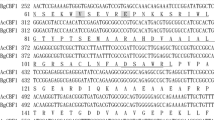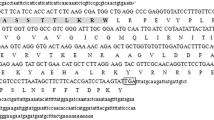Abstract
In Gramineae plants, carbon sequestration is closely related to the internodes development which is regulated by the gibberellins (GAs). Chitin-inducible gibberellin-responsive genes (CICR) are a member of the GRAS superfamily involved in the gibberellin signal transduction pathway and play roles in the development and defense of the plant. In this study, a CICR homolog gene (named BvCIGR) was cloned from the shoot tip of Bambusa ventricosa McClure with shorten internodes by rapid amplification of cDNA ends, which was 2143 bp in length encoding 545 amino acids with typical plant GRAS domain. Expression levels of BvCIGR varied in different positions of internodes in B. ventricosa (highest in the upper, followed by the middle and lowest in the bottom internodes). The results indicated that BvCIGR is possibly involved in the regulation of the internodal elongation of B. ventricosa, and has possible influence on the carbon sequestration potential in bamboo plantations.





Similar content being viewed by others
Literature Cited
Bolle, C. 2004. The role of GRAS proteins in plant signal transduction and development. Planta 218: 683–692.
———, C. Koncz & N. H. Chua. 2000. PAT1, a new member of the GRAS family, is involved in phytochrome A signal transduction. Genes Development 14: 1269–1278.
Chen, S. L., Q. P. Yang & Z. W. Guo. 2008a. Influence of principal environmental factors on shooting, growth and abnormal culm rate of Bambusa ventricosa. Journal of Sichuan Agricultural University 26(1): 117–120.
———, ——— & ———. 2008b. Effects of clump structure on new culm morphological variation of Bambusa ventricosa. Journal of Zhejiang Forestry College 25: 123–126.
Day, R. B., N. Shibuya & E. Minami. 2003. Identification and characterization of two new members of the GRAS gene family in rice responsive to N-acetylchitooligosaccharide elicitor. Biochimica et Biophysica Acta 1625: 261–268.
———, S. Tanabe, M. Koshioka, T. Mitsui, H. Itoh, M. Ueguchi-Tanaka, M. Matsuoka, H. Kaku, N. Shibuya & E. Minami. 2004. Two rice GRAS family genes responsive to N -acetylchitooligosaccharide elicitor are induced by phytoactive gibberellins: evidence for cross-talk between elicitor and gibberellin signaling in rice cells. Plant Molecular Biology 54: 261–272.
Dill, A., H. S. Jung & T. P. Sun. 2001. The DELLA motif is essential for gibberellin-induced degradation of RGA. The Proceedings of the National Academy of Sciences USA 98: 14162–14167.
Hartweck, L. M. 2008. Gibberellin signaling. Planta 229: 1–13.
Hirsch, S. & G. E. D. Oldroyd. 2009. GRAS-domain transcription factors that regulate plant development. Plant Signaling & Behavior 4(8): 698–700.
Isagi, Y., T. Kawahara, K. Kamo & H. Ito. 1997. Net production and carbon cycling in a bamboo Phyllostachys pubescens stand. Plant Ecology 130(1): 41–52.
Itoh, H., A. Shimada, M. Ueguchi-Tanaka, N. Kamiya, Y. Hasegawa, M. Ashikari & M. Matsuoka. 2005. Overexpression of a GRAS protein lacking the DELLA domain confers altered gibberellin responses in rice. The Plant Journal 44: 669–679.
———, M. Ueguchi-Tanaka, Y. Sato, M. Ashikari & M. Matsuoka. 2002. The gibberellin signaling pathway is regulated by the appearance and disappearance of SLENDER RICE1 in nuclei. Plant Cell 14: 57–70.
Lee, M. H., B. Kim, S. K. Song, J. O. Heo, N. I. Yu, S. A. Lee, M. Kim, D. G. Kim, S. O. Sohn, C. E. Lim, K. S. Chang, M. M. Lee & J. Lim. 2008. Large-scale analysis of the GRAS gene family in Arabidopsis thaliana. Plant Molecular Biology 67: 659–670.
Lee, S., H. Cheng, K. E. King, W. Wang, Y. He, A. Hussain, J. Lo, N. P. Harberd & J. Peng. 2002. Gibberellin regulated Arabidopsis seed germination via RGL2, a GAI/RGA-like gene shoes expression is up-regulated following imbibition. Genes & Development 16: 646–658.
Li, R., Z. C. Zhong & M. J. A. Werger. 1997. Studies on the dynamics of the bamboo shoots in Phyllostachys pubescens. Acta Phytoecol Sinica 21: 53–59.
Matsui, T., P. K. Bhowmik & K. Yokozeki. 2004. A cDNA sequence encoding actin gene in moso bamboo shoot and its phylogenetic analysis. Asian Journal of Plant Sciences 3: 128–131.
Peng, J., P. Carol, D. E. Richards, K. E. King, R. J. Cowling, G. P. Murphy & N. P. Harberd. 1997. The Arabidopsis GAI gene defines a signaling pathway that negatively regulates gibberellin responses. Genes & Development 11: 3194–3205.
Pysh, L. D., J. W. Wysocka-Diller, C. Camilleri, D. Bouchez & P. N. Benfey. 1999. The GRAS gene family in Arabidopsis: sequence characterization and basic expression analysis of the SCARECROW-LIKE genes. The Plant Journal 18: 111–119.
Silverstone, A. L., C. N. Ciampaglio & T. P. Sun. 1998. The Arabidopsis RGA gene encodes a transcriptional regulator repressing the gibberellin signal transduction pathway. Plant Cell 10: 155–169.
Swofford, D. 2002. PAUP phylogenetic analysis using parsimony (*and Other Methods). Version 4.0b 10. Sinauer Associates, Sunderland, MA.
Tian, C. G., P. Wan, S. H. Sun, J. Y. Li & M. S. Chen. 2004. Genome-wide analysis of the GRAS gene family in rice and Arabidopsis. Plant Molecular Biology 54: 519–532.
Tong, H., Y. Jin, W. Liu, F. Li, J. Fang, Y. Yin, Q. Qian, L. Zhu & C. Chu. 2009. Dwarf and low-tillering, a new member of the GRAS family, plays positive roles in brassinosteroid signaling in rice. Plant Journal 58(5): 803–816.
Zhou, M. B., P. Yang, P. J. Gao & D. Q. Tang. 2011. Identification of differentially expressed sequence tags in rapidly elongating Phyllostachys pubescens internodes by suppressive subtractive hybridization. Plant Molecular Biology Reporter 29: 224–231.
Acknowledgments
This work was supported by a special grant from the National Natural Science Foundation of China (grant no. 31070590, 30371181 and 30771753) and grant of Natural Science Foundation of Zhejiang Province (grant no. Y3080002 and R303420).
Author information
Authors and Affiliations
Corresponding author
Rights and permissions
About this article
Cite this article
Zhou, M., Zhang, Y. & Tang, D. Characterization and Primary Functional Analysis of BvCIGR, a Member of the GRAS Gene Family in Bambusa ventricosa . Bot. Rev. 77, 233–241 (2011). https://doi.org/10.1007/s12229-011-9079-7
Published:
Issue Date:
DOI: https://doi.org/10.1007/s12229-011-9079-7




